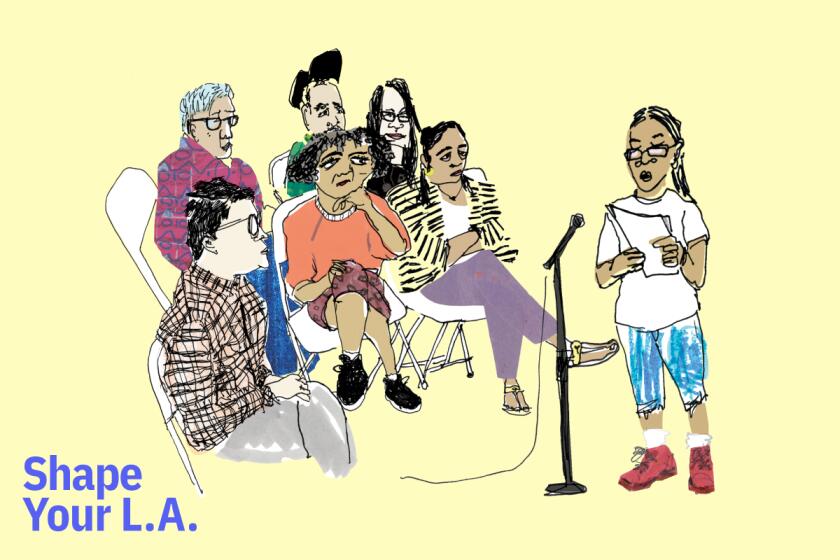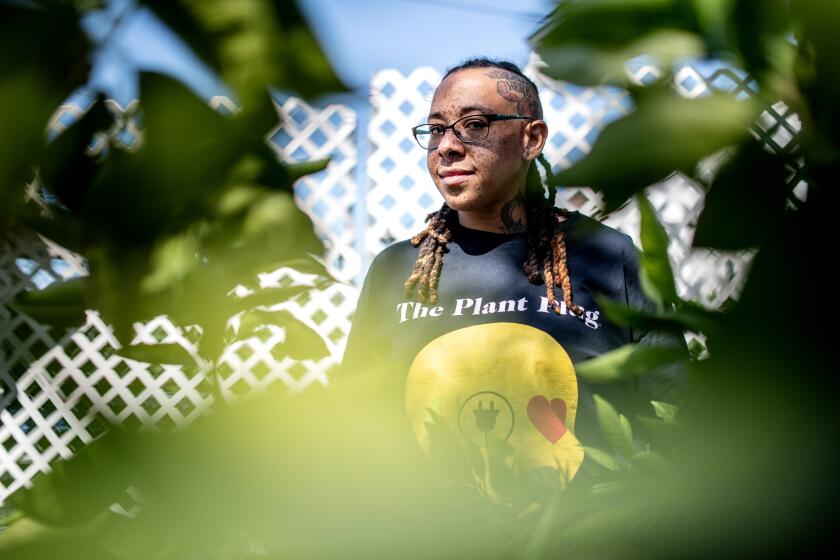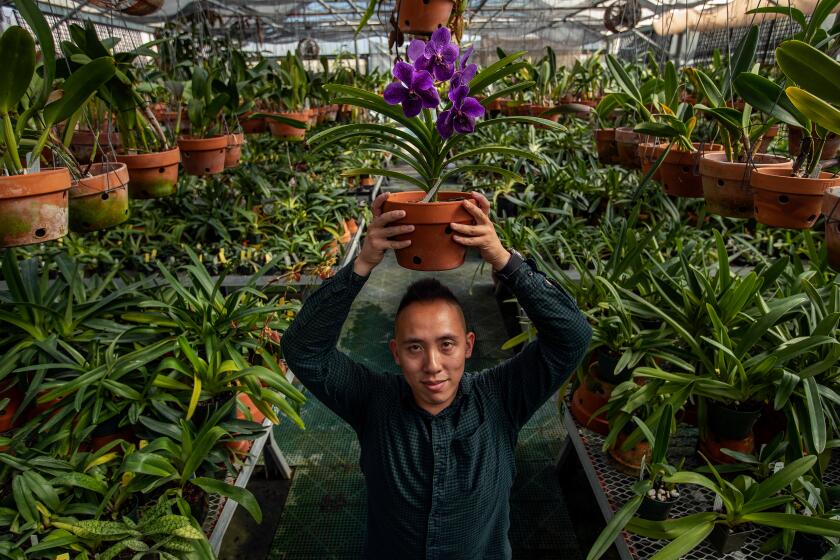How to get into the hottest clubs in L.A. County — community gardens

- Share via
They are some of the most exclusive clubs in town. Some people wait up to two years to become dues-paying members. And no, it’s not the swanky Jonathan Club or hip SoHo House — it’s your local community garden.
About 100 community gardens exist in Los Angeles County, according to the L.A. Community Garden Council, with thousands more around the U.S. A North Carolina State University Agriculture College podcast estimated that “the average community garden generates 20 servings of fresh produce per 11 square feet and can lower household food security concerns by 90%.”
Community gardens can be traced back to “potato patch farms in Michigan in the midst of the recession of 1894,” according to an article in the MIT Press Reader. In times of need, people have found community, nutrition and solace in gardening for a very long time.
Here is why so many people want to join community gardens and a walkthrough of the application process.

What is a community garden?
Community gardens come in five types, according to a University of California Agriculture and Natural Resources publication.
- Neighborhood gardens are public plots of land for use by people in the surrounding area. The members share communal plots and rent individual plots for an annual fee.
- Residential gardens also have individual and communal plots. They are typically shared by a group of people who live in the same place, such as apartments and assisted living facilities.
- Institutional gardens are associated with or owned by private or public organizations such as churches, hospitals and government agencies.
- Demonstration gardens can be considered classrooms or venues for gardening-related workshops. They are used for both education and recreation by the general public.
- School gardens are run by parents, faculty and community volunteers. They teach students about the environment and give them hands-on experience growing their own food.
A garden can be any mix of these five types.
Learn who to talk to in government when you want to get things done in your neighborhood. Get involved in your L.A. County community with the help of our people’s guide to power.
Why join a community garden?
Gardens bring communities together and also benefit people’s health and well-being.
The COVID-19 pandemic and lockdowns were devastating and disruptive in so many ways, said Jesse De La Cruz, the founder of Urbano Strategies and manager of the biggest garden in L.A., the Stanford-Avalon garden. However, “I think if we could have taken a silver lining from that period, [it] was that ... we as a community acknowledge the value that open spaces, green spaces and community gardens have.”
Environmental benefits
While working in these gardens, people learn more about where their food comes from and their individual impact on the environment. They can limit the use of pesticides, which affect the Earth and their health.
Diana Campos Jimenez, until recently the director of the L.A. Community Garden Council, said some gardens offer classes to “practice composting, practice growing seedlings, get educational workshops.” These classes inspire people of all ages to care for their environment and better understand the science behind the plant life cycle.
Plants also contribute to cleaner air as they produce oxygen and remove air pollution during photosynthesis.
And plants take up rainwater, which makes for less runoff in the streets and thus, fewer pollutants making their way into bodies of water.
Health benefits
Community gardens can provide access to fresh produce in areas where it is hard to find affordable or high-quality fresh food.
For the record:
10:03 a.m. Sept. 6, 2023Urbano Strategies founder Jesse De La Cruz is referred to as “Cruz” on subsequent references. Subsequent references to him should have been “De La Cruz.”
Community gardens “become tools for the fight against environmental injustice and food insecurity, because some of these gardens, the reason they started is because they sit in food deserts,” Cruz said.
Campos Jimenez said that traditional gardens can have up to 35 raised beds for growing food. According to a study by the Society for Nutrition Education and Behavior, “Adults with a household member who participated in a community garden consumed fruits and vegetables 1.4 more times per day than those who did not participate.”
They also encourage exercise, the L.A. Garden Community Council website says: “Being active in the outdoors is a wonderful way to help avoid being sedentary, which is a major contributor to obesity.”
Financial benefits
Community gardens improve the property values of surrounding land because they beautify the area, the L.A. Community Garden Council said.
Supplemental income from the sale of produce can help support families.
Some institutional gardens have specialized vocational programs to teach people skills such as landscape maintenance, horticulture and direct marketing.
The produce they grow can also sustain families who can’t afford the price of produce or the cost of driving to a store that has fresh produce.
Cruz said that he has even written a few recommendation letters that helped garden members get jobs.
Social benefits
“This network fosters the meeting of people from diverse backgrounds to share experience and knowledge, promote urban agriculture and economic justice, provide leadership and job training and grow more beautiful and sustainable communities,” Campos Jimenez said.
Cruz said that community gardens were havens during pandemic lockdowns.
“We never closed our gardens,” he said. “We maintained them, and we did use safe practices. It was beneficial to people to get out of their homes for their mental health, social skills and oftentimes you see children developing motor skills and social skills as well.”
Cruz also mentioned training that some gardens offer: “We do a lot of de-escalation, conflict resolution, financial training and leadership development.”
The L.A. Community Garden Council website says that members “foster a sense of ownership and begin to feel more personally invested in their neighborhood.”
Taylor Lindsey connects L.A. to urban farming practices through the Plant Plug, her South Los Angeles nursery and garden. She also hosts monthly gardening workshops.
How to join a community garden
How do you find one to join? Use the Los Angeles Community Garden Council website’s “Find a Garden” feature (lagardencouncil.org/find-a-garden) to look for one near you. The Times’ Shape Your L.A. tool can also help you locate a garden and more local resources.
The application process typically starts with filling out a form — online or at the garden.
Then comes the wait list. The gardens with the quickest turnover of membership requests have waiting periods of three to six months. For larger gardens, such as the Stanford-Avalon Community Garden, which counts about 230 families as members, waiting lists stretch as long as two years. So patience and persistence are required.
If there is a garden open, applicants usually attend an orientation to talk about expectations, the garden rules and agreements, and how dues are collected, Cruz said. Sometimes garden leadership requests that an applicant attend meetings so they can gauge whether they are genuinely interested and that they understand what will be asked of them.
With newer gardens, the managers will take in families based on whatever system they choose — for example, a lottery or first-come-first-served. If people worked on the land before it was formalized into a community garden, they typically get grandfathered into a membership.
The L.A. Community Garden Council recommends that you contact your preferred garden directly and ask if any volunteer opportunities are available.
“If a garden does have a volunteer opportunity available, they’ll tell you when to stop by, what to wear, what to bring, what type of work to expect. And once you get to the garden, you will be asked to sign a volunteer waiver, and after that, you can come as often as you’d like,” Campos Jimenez said.
Some gardens have “open hours,” which are dedicated to any local who just wants to show up and learn about the garden. Ask about open hours at your local garden.
The L.A. Community Garden Council has email addresses attached to every garden on its “Find a Garden” tool. Many gardens also have social media accounts or websites — so if you see one nearby, look it up online.
Sandra Mejia and her husband, Bantalem Adis, opened the Plant Chica to greenify South L.A. Now, they might have to leave to make way for new construction in a changing neighborhood.
How much does it cost?
The fee to join a garden varies. According to Campos Jimenez, member fees offset garden costs, “including water, insurance and any lease fees that they need to pay.”
As for the duration of memberships, she said that some gardens don’t have a designated time period. Others have anywhere from three to five years.
The way to keep your membership is by being a good member of the community, she said. “Usually a member in good standing means someone that actively participates in the garden, participates in membership meetings, pays their garden membership dues on time,” she said.
Associate curator Brandon Tam keeps watch over at least 10,000 orchids with 1,500 unique species inside the Huntington’s dedicated greenhouses.
More to Read
Sign up for Essential California
The most important California stories and recommendations in your inbox every morning.
You may occasionally receive promotional content from the Los Angeles Times.


















